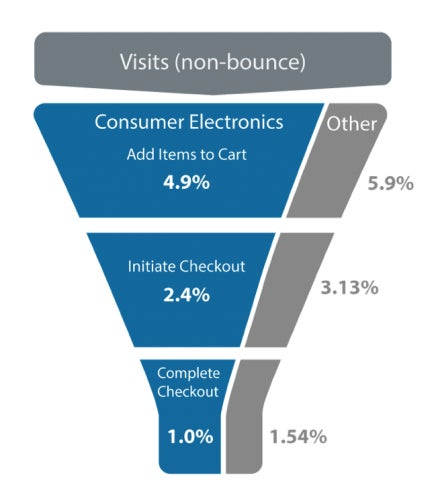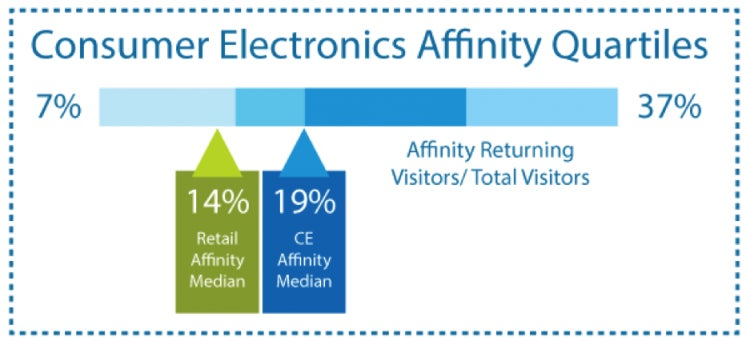Rise to the Top in Consumer Electronics

Although many industries have director-to-consumer models, selling consumer electronics is especially tricky, with complex business models and competing channels. The space is highly fluid and the competitive landscape is in constant flux. In recent years, rapid innovation has defined the industry, as technology has changed and evolved very quickly. Each cycle of innovation brings new winners and losers, leaders and laggards. This focus on innovation and evolution has had the unintended consequence that new technology is quickly commoditized and imitated by competitors. Consumer electronics companies must then find other ways to differentiate, such as price, quality, customizability, customer experience, and so on.
The complex, competitive nature of this retail segment was highlighted in recent research by Adobe’s Digital Index team. By comparing the ecommerce funnel of consumer electronics companies to the general pool of other retailer categories—including apparel, home improvement, department store, furnishings, toys, recreational products, etc.—it becomes apparent that typical digital marketing practices may not be as effective for marketers of consumer electronics. Notice in the image below that the research showed a much tighter funnel, at every stage, for consumer electronics companies. Consumer electronics marketers are dealing with a higher rate of abandonment at each stage of the buying cycle and in the conversion funnel.

http://blogs.adobe.com/digitalmarketing/wp-content/uploads/2015/04/Picture1.png
The tighter funnel and lower conversion rate may be explained by several factors especially prevalent in the consumer electronics space such as undifferentiated products, price sensitivity, the propensity for “window shopping” online, consumer preferences for other channels, and so on. Or perhaps the digital experiences that many consumer electronics companies provide is simply lacking. Regardless, there is clearly an issue.
What can marketers of consumer electronics do to bridge the gap and bring their metrics up to meet and exceed their colleagues in other retail segments? Although typical conversion rate optimization techniques apply (i.e., testing, copy optimization, online surveys, segmentation, etc.) companies should begin by analyzing site behavior data. Unearthing the drivers of this tighter funnel is the first, and most important, step. Analysis could include the customer journey, cart abandonment, pathing, and other advanced analytics techniques. These analyses will help in understanding where customers are falling out, common traits or behaviors of abandoners and purchases, and even the varying conversion rates of specific products and segments. With the insights gleaned from these analyses, companies will be better prepared to address and serve this unique customer base.
The higher goal though, and the most effective way to increase conversion rates across journeys and channels, is personalization. The value of personalization seems to be well understood, Adobe’s recent Digital Trends report shows “Targeting and Personalization” to be the top digital-related priority across industries. But additional analysis performed by Adobe’s Digital Index team on the tech retailer sub-segment reveals an interesting opportunity: affinity (i.e. the percentage of total visitors that are returning visitors) is much higher in the tech retailer space than in the rest of retail.

http://blogs.adobe.com/digitalmarketing/wp-content/uploads/2015/04/Picture2.png
This means that, compared to other retailers, consumer electronics companies have a higher percentage of visitors who have previously been to their website and are now returning. This unique behavior represents a significant opportunity for marketers. Each time a visitor comes to the site is an opportunity to gather and assemble new information and data on that specific visitor, shedding a little more light onto who that customer is and what their intentions are, expanding and refining their customer profile with every interaction. Each visit is a chance to deliver an increasingly personalized and relevant digital experience.
The consumer electronics space is unique and the data proves that it is a challenging market. Retailers of consumer electronics can begin to level the playing field by using data to gain a deeper and more holistic understanding of their customers. By then taking advantage of the unique opportunity to deliver personalized and relevant experiences to returning visitors, tech retailers can begin to close the gap in ecommerce funnels and conversion rates.